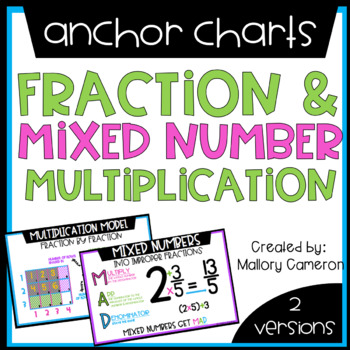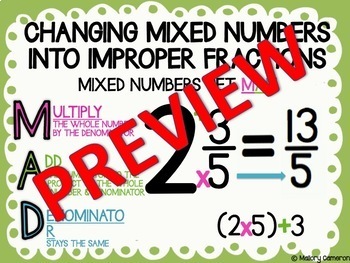Fraction and Mixed Number Multiplication Anchor Charts
Mallory Cameron
2.7k Followers
Mallory Cameron
2.7k Followers
What educators are saying
Loved these, my students were having a hard time understanding this standard as they have now are able to understand with pictures and detailed descriptions.
This is a great resource that fit perfectly with my lesson and easy to use. My students were engaged and had no trouble getting started. Thank you.
Description
PRINT AND GO ANCHOR CHARTS!
My Fraction and Mixed Number Multiplication Anchor Charts are a perfect addition to use in your whole group or small group math instruction. They are sized 11x17; therefore, they are perfect to hang on bulletin boards for easy viewing for your students. I also like to print multiple to a page to put into my students' interactive journals for notes to refer back to throughout the unit.
TOPICS COVERED:
- fraction by whole number multiplication
- fraction by fraction whole number multiplication model
- fraction by fraction multiplication
- fraction by fraction multiplication model
- mixed number multiplication
- changing mixed numbers into improper fractions
- changing improper fractions into mixed numbers
- comparing fractions
- comparing mixed numbers
STANDARDS COVERED:
- CC.5.NF.4a
- CC.5.NF.5a
- CC.5.NF.5b
- CC.5.NF.6
I revamped one of my older products with a more clean, crisp, and modern look!
Both the old and new version are included when downloading this product.
Check out my other math anchor charts:
Customary and Metric Measurement Anchor Charts
My Fraction and Mixed Number Multiplication Anchor Charts are a perfect addition to use in your whole group or small group math instruction. They are sized 11x17; therefore, they are perfect to hang on bulletin boards for easy viewing for your students. I also like to print multiple to a page to put into my students' interactive journals for notes to refer back to throughout the unit.
TOPICS COVERED:
- fraction by whole number multiplication
- fraction by fraction whole number multiplication model
- fraction by fraction multiplication
- fraction by fraction multiplication model
- mixed number multiplication
- changing mixed numbers into improper fractions
- changing improper fractions into mixed numbers
- comparing fractions
- comparing mixed numbers
STANDARDS COVERED:
- CC.5.NF.4a
- CC.5.NF.5a
- CC.5.NF.5b
- CC.5.NF.6
I revamped one of my older products with a more clean, crisp, and modern look!
Both the old and new version are included when downloading this product.
Check out my other math anchor charts:
Customary and Metric Measurement Anchor Charts
Total Pages
29 pages
Answer Key
N/A
Teaching Duration
N/A
Report this resource to TPT
Reported resources will be reviewed by our team. Report this resource to let us know if this resource violates TPT’s content guidelines.
Standards
to see state-specific standards (only available in the US).
CCSS4.NF.A.2
Compare two fractions with different numerators and different denominators, e.g., by creating common denominators or numerators, or by comparing to a benchmark fraction such as 1/2. Recognize that comparisons are valid only when the two fractions refer to the same whole. Record the results of comparisons with symbols >, =, or <, and justify the conclusions, e.g., by using a visual fraction model.
CCSS4.NF.B.4
Apply and extend previous understandings of multiplication to multiply a fraction by a whole number.
CCSS4.NF.B.4c
Solve word problems involving multiplication of a fraction by a whole number, e.g., by using visual fraction models and equations to represent the problem. For example, if each person at a party will eat 3/8 of a pound of roast beef, and there will be 5 people at the party, how many pounds of roast beef will be needed? Between what two whole numbers does your answer lie?
CCSS5.NF.B.4
Apply and extend previous understandings of multiplication to multiply a fraction or whole number by a fraction.
CCSS5.NF.B.4a
Interpret the product (𝘢/𝘣) × 𝘲 as a parts of a partition of 𝘲 into 𝘣 equal parts; equivalently, as the result of a sequence of operations 𝘢 × 𝘲 ÷ 𝘣. For example, use a visual fraction model to show (2/3) × 4 = 8/3, and create a story context for this equation. Do the same with (2/3) × (4/5) = 8/15. (In general, (𝘢/𝘣) × (𝘤/𝘥) = 𝘢𝘤/𝘣𝘥.)





